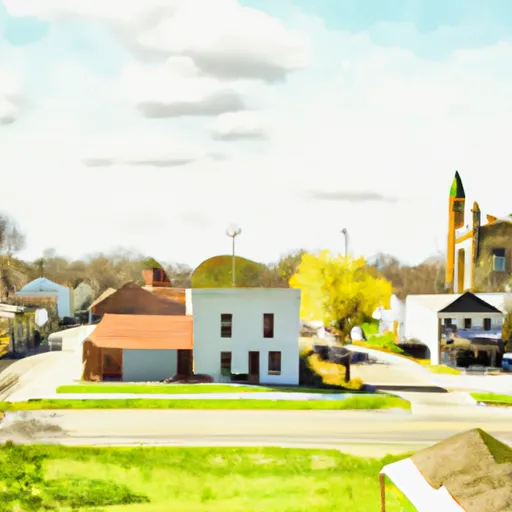-
 Snoflo Premium
Snoflo Premium
Get unlimited access to all our content
With no Ad interruptions! - Start Your Free Trial Login with existing account
Hillsboro
Eden Index
Climate
8.1
•
Recreation
3.7
•
Community
•
Safeguard
4.5/10

Hillsboro, Indiana is a small town located in Fountain County, in the western part of the state. The climate is characterized by warm summers and cold winters. The average high temperature in July is around 85°F, while January brings temperatures averaging around 30°F. Precipitation is evenly distributed throughout the year, with an average annual rainfall of about 40 inches.
Hydrologically, Hillsboro is situated near the banks of Coal Creek. The area is known for its fertile farmland, which benefits from the water supply provided by this creek. The presence of Coal Creek also contributes to the town's natural beauty.
Outdoor enthusiasts can enjoy various recreational activities in and around Hillsboro. The area offers opportunities for fishing, boating, and kayaking on Coal Creek. Additionally, there are several nearby parks and nature preserves where visitors can hike, bike, or have a picnic. Turkey Run State Park, situated a short drive away, is particularly popular for its scenic trails, towering sandstone cliffs, and diverse wildlife.
In summary, Hillsboro, Indiana boasts a pleasant climate, with distinct seasons, and benefits from the hydrological features of Coal Creek. The town's proximity to natural areas and parks provides residents and visitors with ample opportunities for outdoor recreation.
What is the Eden Index?
The Snoflo Eden Index serves as a comprehensive rating system for regions, evaluating their desirability through a holistic assessment of climate health, outdoor recreation opportunities, and natural disaster risk, acknowledging the profound impact of these factors on livability and well-being.
Climate Health Indicator (CHI): 8.1
Hillsboro receives approximately
1043mm of rain per year,
with humidity levels near 83%
and air temperatures averaging around
11°C.
Hillsboro has a plant hardyness factor of
5, meaning
plants and agriculture in this region thrive during a short period during spring and early summer. Most
plants will die off during the colder winter months.
By considering the ideal temperature range, reliable water supplies, clean air, and stable seasonal rain or snowpacks, the Climate Health Indicator (CHI) underscores the significance of a healthy climate as the foundation for quality living.
A healthy climate is paramount for ensuring a high quality of life and livability in a region, fostering both physical well-being and environmental harmony. This can be characterized by ideal temperatures, reliable access to water supplies, clean air, and consistent seasonal rain or snowpacks.
Weather Forecast
Streamflow Conditions
Wabash
Area Rivers
Wabash
Snowpack Depths
Wabash
Reservoir Storage Capacity
Wabash
Groundwater Levels
Recreational Opportunity Index (ROI): 3.7
The Recreational Opportunity Index (ROI) recognizes the value of outdoor recreational options, such as parks, hiking trails, camping sites, and fishing spots, while acknowledging that climate plays a pivotal role in ensuring the comfort and consistency of these experiences.
Access to outdoor recreational opportunities, encompassing activities such as parks, hiking, camping, and fishing, is crucial for overall well-being, and the climate plays a pivotal role in enabling and enhancing these experiences, ensuring that individuals can engage in nature-based activities comfortably and consistently.
Camping Areas
| Campground | Campsites | Reservations | Toilets | Showers | Elevation |
|---|---|---|---|---|---|
| West Boggs Park | 220 | 528 ft | |||
| Pike State Forest | 25 | 520 ft | |||
| Glendale State Fish and Wildlife Area | 120 | 495 ft | |||
| Harpeth River Bridge | None | 393 ft | |||
| Prides Creek Co Park | None | 485 ft | |||
| Montgomery Bell State Park | 80 | 618 ft | |||
| Montgomery Rec Park | None | 515 ft | |||
| Res 26 - Greene - Sullivan State Forest | 25 | 498 ft | |||
| Sunset City Park | None | 548 ft | |||
| Greene - Sullivan State Forest | None | 521 ft |
Nearby Fishing
Nearby Ski Areas
Catastrophe Safeguard Index (CSI):
The Catastrophe Safeguard Index (CSI) recognizes that natural disaster risk, encompassing floods, fires, hurricanes, and tornadoes, can drastically affect safety and the overall appeal of an area.
The level of natural disaster risk in a region significantly affects safety and the overall livability, with climate change amplifying these risks by potentially increasing the frequency and intensity of events like floods, fires, hurricanes, and tornadoes, thereby posing substantial challenges to community resilience and well-being.
Community Resilience Indicator (CRI):
The Community Resilience Indicator (CRI) recognizes that education, healthcare, and socioeconomics are crucial to the well-being of a region. The CRI acknowledges the profound impact of these elements on residents' overall quality of life. By evaluating educational resources, healthcare accessibility, and economic inclusivity, the index captures the essential aspects that contribute to a thriving community, fostering resident satisfaction, equity, and social cohesion.

